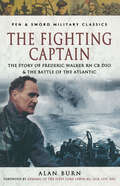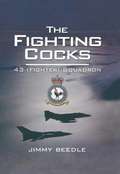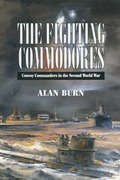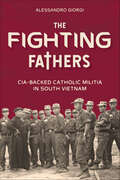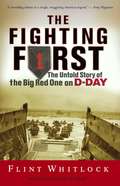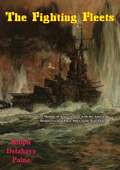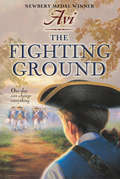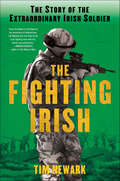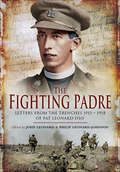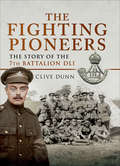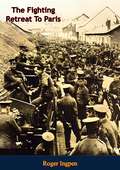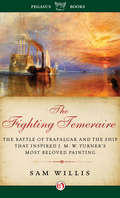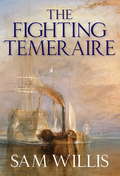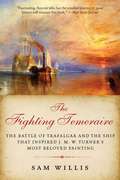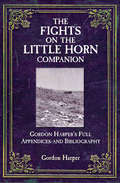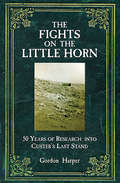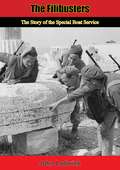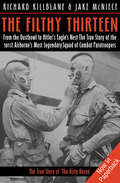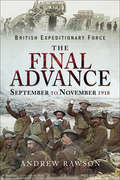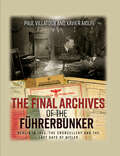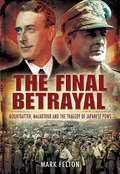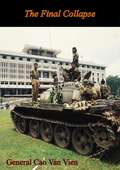- Table View
- List View
The Fighting Captain: The Story of Frederic Walker RN CB DSO & The Battle of the Atlantic (Pen & Sword Military Classics)
by Alan BurnA riveting account of the World War II naval career of the man who did more to win the Battle of the Atlantic than any other officer at sea.Captain F. J. Walker, RN, dedicated his life to defeating the Germans—and Karl Dönitz, Führer der U-Boote, in particular—by containing the U-boats, wearing them down, and sending them back to their bunkers.He was a formidable figure and one of the greatest fighting captains in the Royal Navy, sinking twenty U-boats. For this he was awarded a CB and four DSOs. A month after D-Day, exhausted by his continuous actions at sea against the enemy and his successful exertions to keep the U-boats out of the English Channel to ensure the safe passage of the Allied landings at D-day, he went ashore in Liverpool after a patrol. His ships and the men he had trained and inspired were already back at sea when he died on the 9 July, 1944, aged 48. His ships went on to sink another nine U-boats, bringing his flotillas’ total up to twenty-nine, before the U-boat fleet finally surrendered. Fifteen of which were sunk by Walker’s own ship, HMS Starling.
The Fighting Cocks: 43 (Fighter) Squadron
by Jimmy BedleIn April 1916, a group of early aviators gathered in the fields beneath the crags and ramparts of Stirling Castle to form what was to become one of the Royal Air Forces most distinguished fighter squadrons.Few squadrons can match the history of 43 Squadron which has included being the first to undertake ground attack operations during the First World War, shooting down the first enemy aircraft over England in the Second World War, and achieving the remarkable double of shooting down 6 enemy aircraft in one day in both World Wars. Its distinctive emblem of the Fighting Cock embodies the spirit and resilience of a fighter squadron that has been in the vanguard of RAF operations for almost a century. Perhaps the Fighting Cocks finest period occurred during the Battle of Britain when its Hurricanes destroyed 60 enemy aircraft with a further thirteen probables and twenty-five more damaged.With the advent of the jet age, 43 Squadron became the first unit to fly the Hunter, seeing operational duties in Aden, before re-equipping with the Phantom until the end of the Cold War. This new edition of the Fighting Cocks history brings the story up to date and covers its 20 years of service with the Tornado F3, including the Gulf War, NATO operations over Bosnia, and the Iraq War. * This new edition of the Fighting Cocks history brings the story up to date * Few squadrons can match the history of 43 Squadron* Fighting Cock embodies the spirit and resilience of a fighter squadron that has been in the vanguard of RAF operations for almost a century
The Fighting Commodores: Convoy Commanders in the Second World War
by Alan BurnAs Britain came terrifyingly close to running out of supplies during the Second World War, a group of retired senior naval officers returned to the sea in the role of convoy commanders, and thereby turned the tide.
The Fighting Fathers: CIA-Backed Catholic Militia in South Vietnam
by Alessandro GiorgiAn untold story of espionage, religion, and guerilla warfare in South Vietnam. During the early years of US involvement in Vietnam, the CIA helped arm militia groups in South Vietnam referred to as the “Fighting Fathers.” The name was a reference to the Catholic priests who organized the fighting groups. The fathers fought alongside their parishioners to defend their localities from the Communist insurgency, the Vietcong. Author Alessandro Giorgi has studied the subject in unprecedented detail, conducting original research in recently declassified archives and interviewing former US intelligence personnel and Italian missionary witnesses.
The Fighting First: The Untold Story of the Big Red One on D-Day
by Flint Whitlock<p><i>The Fighting First</i> recounts the untold story of the 1st Infantry Division's role in the invasion of France at Normandy. Using primary sources, official records, interviews, and unpublished memoirs by the veterans themselves, Flint Whitlock has crafted a riveting, gut-wrenching, personal story of courage under fire. <p>Operation Overlord-the Allied invasion of Normandy on 6 June 1944-was the most important battle of World War II, and Omaha Beach was the hottest spot in the entire operation. Leading the amphibious assault on the "Easy Red" and "Fox Green" sectors of Omaha Beach was the U.S. Army's 1st Infantry Division-"The Big Red One"-a tough, swaggering outfit with a fine battle record. <p>The saga of the Big Red One, however, did not end with the storming of the beachhead, but continued across France, Belgium, and into Germany itself, where the division fought in the battles for Aachen, the Huertgen Forest, and the Battle of the Bulge. <i>The Fighting First</i> is an inspiring, graphic, and often heart-breaking story of young American soldiers performing their missions with spirit, humor, and determination.</p>
The Fighting Fleets: Five Months of Active Service with the American Destroyers and Their Allies in the War Zone
by Ralph Delahaye PaineA look at the day-to-day work of the Allied Naval Forces during the First World War, particularly in regard to the relationship between the British navy and the U.S. navy in 1918. It is partly based on the author’s five months of active service with the American destroyers, and makes for some interesting reading about World War I submarines and destroyers. Ralph D. Paine was an American author of many maritime books and a friend of Stephen Crane, author of The Red Badge of Courage.
The Fighting Fourth: No. 4 Commando at War 1940-45
by James DunningCovering the legendary Lofoten and Dieppe raids, the D-Day landings and the capture of Flushing, James Dunning recounts the history of No. 4 Commando, an elite wartime special service unit, from formation in 1940 to disbandment five years later. The author, himself, a ‘Fighting Fourth’ veteran, describes how 500 volunteers, despite initial problems, prejudices and frustrations, developed into one of the most feared fighting formations of the Second World War. The extraordinarily tough and unorthodox training undertaken by No. 4 Commando prepared them for the raids of 1941 and 1942, their protracted involvement on D-Day and for 83 days’ action in the struggle for Normandy. Their last major operation was the storming and capture of the vital port of Flushing in November 1944. This readable and authoritative history of the unit reveals their important role in the Second World War.
The Fighting Ground
by AviApril 3, 1778<P><P>He may be just thirteen, but Jonathan knows he's ready to go to the war against the British. He can handle a gun. He yearns to battle for glory, just like his brother and cousin.So when Jonathan hears the tavern bell toll, calling men to fight, he runs to join them. He doesn't realize that in just twenty-four hours, his life will be forever altered -- by the war, by his fellow soldiers, and by the terrible choices he must make. <P><b> Winner of the Scott O'Dell Award for Historical Fiction </b>
The Fighting Irish: The Story of the Extraordinary Irish Soldier
by Tim NewarkTim Newark's The Fighting Irish uses the dramatic words of the soldiers themselves to tell their stories, gathered from diaries, letters, journals, and interviews with veterans in Ireland and across the world. "Tells the story of the Irish fighting man with wit, clarity, and scholarship." —Andrew Roberts, author of The Storm of WarFor hundreds of years, Irish soldiers have sought their destiny abroad. Wherever they've traveled, whichever side of the battlefield they've stood, the tales of their exploits have never been forgotten.Leaving his birthplace, the Irish soldier has traveled with hope, often seeking to bring a liberating revolution to his fellow countrymen. In search of adventure the Fighting Irish have been found in all corners of the world. Some sailed to America and joined in frontier fighting, others demonstrated their loyalty to their adopted homeland in the bloody combats of the American Civil War, as well as campaigns against the British Empire in Canada and South Africa. The Irish soldier can also be found in the thick of war during the twentieth century—facing slaughter at the Somme, desperate last-stands in the Congo—and, more recently, in Iraq and Afghanistan.
The Fighting Padre: Pat Leonard's Letters From the Trenches, 1915–1918
by John Leonard Philip Leonard-JohnsonPat Leonard served throughout the Great War as a Chaplain to the Forces in France, Belgium and, after the Armistice, in Germany. Along with the many hundreds of letters he wrote to the relatives of those parishioners who died or were wounded, he found time to describe for his parents back at home the awful reality of life in the Trenches, and on the makeshift aerodromes from which the pilots of the Royal Flying Corps operated from the Observers seat which liberated his spirit from the mud of Flanders. Very much a front-line priest, his descriptions provide an unusually objective view of army life, and of the job of the multitasked chaplain who was expected to undertake the roles of counselor, comforter, caterer, censor, entertainment officer and sports supreme to name but a few. The extracts selected from his letters are full of detail, humor, self deprecation and just sometimes when judged by todays standards, mild political incorrectness! Known as a veritable fighting parson (because of his prowess in the boxing ring) he also played rugby for the RAF, was mentioned in dispatches, and was decorated for bravery. 90 years have passed before this opportunity arises to share his account of a life which the world remembers as dreadful beyond belief. Reading it demonstrates that despite the ghastliness, human qualities emerged with which we should all be proud. Pat Leonard was born in 1889 into a clergy family in Cumbria, MPG (Pat) Leonard went from being Head of School at Rossall to Oriel College, Oxford on a mathematics scholarship. After graduating and obtaining a TA Commission in the Kings Own Royal Lancaster Regiment, Leonard served as a curate in a Manchester parish before being accepted as Chaplain to the 8th Battalion, the Kings Own, from September 1915 in the battlefields of the Somme Awarded the DSO for bravery and mentioned in dispatches, he transferred to the RFC in early 1918. After the war he was much involved in the development and growth of TocH throughout the world. Subsequently after a period as Rector of Hatfield and ten years in Glasgow as Provost of St. Marys Cathedral he was consecrated Bishop of Thetford in 1953.
The Fighting Pioneers: The Story of the 7th Battalion DLI
by Clive DunnStory of the 7th Battalion Durham Light Infantry. With the creation of the Territorial Force in 1908 the battalion was re-designated as the 7th Battalion. It went to France in April 1915 with the rest of the Northumbrian Division seeing action almost immediately at the Second battle of Ypres. In November 1915 the battalion was picked to become the divisional pioneers. The 1/7 Battalion suffered 600 fatalities. In 1920 when the Territorial Army was reformed it was re-raised in its original role as infantry. The story concludes on 10 December 1936 when the 7th Battalion Durham Light Infantry became the 47th (Durham Light Infantry) A.A. Battalion R.E. (T.A.), whose personnel went on to serve in the Second World War.
The Fighting Retreat To Paris
by Roger IngpenIncludes The First World War On The Western Front 1914-1915 Illustrations Pack with 101 maps, plans, and photos.A fascinating view of the opening phases of the First World War.“Imperial Germany had long planned the conflict that was to become the First World War, but when the onslaught came there was little sign that the nations which would be embroiled were prepared for the storm. Germany advanced in the east and west where French and Belgian armies were forced to retire by overwhelming odds. The small British Army, the 'B. E. F', was rushed to the continent with most of its troops having less than a week between garrison life and the firing line. Under Sir John French, it was allocated the western end of the line, and at Mons it inflicted far more causalities on the enemy than its numbers would suggest. No army of its size, however, could stand against the German superiority in men (at least five to one) or artillery and machine guns. An envelopment was inevitable and so a stubbornly fought retreat was ordered. Near Le Cateau, the British turned at bay and Smith-Dorrien's determination to stand and fight undoubtedly saved the British Army from annihilation. Many people imagine the First World War as a stalemate of mud, wire and trenches, but in the first six months it was a great European war fought in much the same way that Napoleon, Wellington and Blucher had fought a century before.”-Print ed.
The Fighting Temeraire
by Sam WillisThe extraordinary story of the mighty Temeraire, the ship behind J. M. W. Turner's iconic painting The H.M.S. Temeraire, one of Britains most illustrious fighting ships, is known to millions through J.M.W. Turners masterpiece, The Fighting Temeraire (1839), which portrays the battle-scarred veteran of Britain's wars with Napoleonic France. In this evocative new volume, Sam Willis tells the extraordinary story of the vessel behind the painting. This tale of two ships spans the heyday of the age of sail: the climaxes of both the Seven Years' War (1756-63) and the Napoleonic Wars (1798-1815). Filled with richly evocative detail, and narrated with the pace and gusto of a master storyteller, The Fighting Temeraire is an enthralling and deeply satisfying work of narrative history.
The Fighting Temeraire: Legend of Trafalgar (Hearts of Oak Trilogy Vol.1) (Hearts of Oak Trilogy)
by Sam WillisJ.M.W. Turner's The Fighting Temeraire Tugged to her Last Berth to be Broken Up (1838) was his masterpiece. Sam Willis tells the real-life story behind this remarkable painting. The 98-gun Temeraire warship broke through the French and Spanish line directly astern of Nelson's flagship Victory during the Battle of Trafalgar (1805), saving Nelson at a crucial moment in the battle, and, in the words of John Ruskin, fought until her sides ran 'wet with the long runlets of English blood...those pale masts that stayed themselves up against the war-ruin, shaking out their ensigns through the thunder, till sail and ensign dropped.' It is a story that unites the art of war as practised by Nelson with the art of war as depicted by Turner and, as such, it ranges across an extensive period of Britain's cultural and military history in ways that other stories do not. The result is a detailed picture of British maritime power at two of its most significant peaks in the age of sail: the climaxes of both the Seven Years' War (1756-63) and the Napoleonic Wars (1798-1815). It covers every aspect of life in the sailing navy, with particular emphasis on amphibious warfare, disease, victualling, blockade, mutiny and, of course, fleet battle, for it was at Trafalgar that the Temeraire really won her fame. An evocative and magnificent narrative history by a master historian.
The Fighting Temeraire: The Battle of Trafalgar and the Ship that Inspired J. M. W. Turner's Most Beloved Painting
by Sam WillisThe extraordinary story of the mighty Temeraire, the ship behind J. M. W. Turner's iconic painting. The H.M.S. Temeraire, one of Britain's most illustrious fighting ships, is known to millions through J. M. W. Turner's masterpiece, The Fighting Temeraire (1839), which portrays the battle-scarred veteran of Britain's wars with Napoleonic France. In this evocative new volume, Sam Willis tells the extraordinary story of the vessel behind the painting. This tale of two ships spans the heyday of the age of sail: the climaxes of both the Seven Years' War (1756-63) and the Napoleonic Wars (1798-1815). Filled with richly evocative detail, and narrated with the pace and gusto of a master storyteller, The Fighting Temeraire is an enthralling and deeply satisfying work of narrative history.
The Fights on the Little Horn Companion: Gordon Harper's Full Appendices and Bibliography
by Gordon HarperA treasury of sources and supplemental information for readers of the award-winning history The Fights on the Little Horn. This volume collects and lists books, booklets, pamphlets, manuscripts, personal and family papers, newspapers, magazines, periodicals, correspondence, interviews, military and historical journals, military and government reports, and more used by Gordon Harper, author of The Fights on the Little Horn, in his extraordinary years-long research into Custer&’s Last Stand. As a companion volume to that book, or a resource for anyone interested in the history of the American West, it is a valuable and comprehensive guide.
The Fights on the Little Horn: 50 Years of Research into Custer's Last Stand
by Gordon HarperWinner of the John Carroll Award and the G. Joseph Sills Jr. Book Award. A deeply researched work on the infamous 1876 battle, filled with new discoveries. This remarkable book synthesizes a lifetime of in-depth research into one of America&’s most storied disasters, the defeat of Custer&’s 7th Cavalry at the hands of the Sioux and Cheyenne, as well as the complete annihilation of that part of the cavalry led by Custer himself. The author, Gordon Harper, spent countless hours on the battlefield itself, as well as researching every iota of evidence of the fight from both sides, white and Indian. He was thus able to recreate every step of the battle as authoritatively as anyone could, dispelling myths and falsehoods along the way. When he passed away in 2009, he left nearly two million words of original research and writing, and in this book, his work has been condensed for the general public to observe his key findings and the crux of his narrative on the exact course of the battle. One of his first observations is that the fight took place along the Little Horn River—its junction with the Big Horn was several miles away—so the term for the battle, &“Little Big Horn&” has always been a misnomer. He precisely traces the mysterious activities of Benteen&’s battalion on that fateful day, and why it couldn&’t come to Custer&’s reinforcement. He describes Reno&’s desperate fight in unprecedented depth, as well as how that unnerved officer benefited from the unexpected heroism of many of his men. Indian accounts, ever-present throughout this book, come to the fore especially during Custer&’s part of the fight, because no white soldier survived it. However, analysis of the forensic evidence—like tracking cartridges and bullets discovered on the battlefield, plus the locations of bodies—assist in drawing an accurate scenario of how the final scene unfolded. It may indeed be clearer now than it was to the doomed 7th Cavalrymen at the time, who, through the dust and smoke and Indians seeming to rise by hundreds from the ground, only gradually realized the extent of the disaster. Of additional interest is the narrative of the battlefield after the fight, when successive burial teams had to be dispatched for the gruesome task because prior ones invariably did a poor job. Though the author is no longer with us, his daughter Tori Harper, along with historians Gordon Richard and Monte Akers, have done yeoman&’s work in preserving his valuable research for the public. &“Having read and studied several previous books on the Custer Battle, I was hoping that something new would emerge and I was not disappointed . . . certainly a book that one cannot put down.&” —Norman Franks, author of Ton-Up Lancs and Under the Guns of the Red Baron
The Filibusters: The Story of the Special Boat Service
by John LodwickFirst published in 1947, this novel from British author John Lodwick is an accolade to the British Special Boat Service (SBS), a commando force of some 300 men that inflicted great damage on the enemy in the Mediterranean and the Aegean seas during World War II.Founded in July 1940 by Commando officer Roger Courtney, and initially named the Folboat Troop—after the type of folding canoe employed in raiding operations—the Special Boat Service became the special forces unit of the Naval Service of the United Kingdom. Together with the Special Air Service, Special Reconnaissance Regiment and the Special Forces Support Group, they form the United Kingdom Special Forces and come under joint control of the same Director Special Forces.In The Filibusters: The Story of the Special Boat Service, Lodwick reflects his war experiences and exploits as an officer in the Special Boat Service.
The Filthy Thirteen: From the Dustbowl to Hitler's Eagle's Nest—The True Story of the 101st Airborne's Most Legendary Squad of Combat Paratroopers
by Richard Killblane Jake McNieceThe true story of the 101st Airborne Division&’s most notorious squad of combat paratroopers—the inspiration for the classic WWII film, The Dirty Dozen. Since World War II, the American public has learned of the exploits of the 101st Airborne Division, the paratroopers who led the Allied invasions into Nazi-held Europe. But within the ranks of the 101st, one unit attained truly legendary status. Known as the Filthy Thirteen, they were the real-life inspiration for The Dirty Dozen. Primarily products of the Dustbowl and the Depression, the Filthy Thirteen became notorious within the elite Screaming Eagles for their hard drinking and savage fighting skills. From D-Day until the end of the war, the squad&’s heart and soul—and its toughest member—was a half Native American soldier named Jake McNiece. McNiece made four combat jumps, was in the forefront of every fight in northern Europe, yet somehow never made the rank of PFC. The Filthy Thirteen offers a vivid group portrait of hardscrabble guys whom any respectable person would be loath to meet in a dark alley: a brawling bunch whose saving grace was that they inflicted more damage on the Germans than on MPs, the English countryside, and their own officers.
The Final Advance, September to November 1918: September to November 1918 (British Expeditionary Force)
by Andrew RawsonThis is the story the British Expeditionary Forces part in the final days of the Advance to Victory. It starts with the massive offensive against the Hindenburg Line at the end of September 1918. Second Army launched the first of the British attacks in Flanders on the 28th, followed by Fourth Army the next day along the St Quentin Canal.Both First and Third Armies joined in, breaking the Hindenburg Line across the Lys plain and the Artois region, taking Cambrai by 10 October. The narrative then follows the advance through the battles of the River Selle and the River Sambre. It culminates with the final operations, including the actions at Maubeuge and Mons, just before the Armistice on 11 November 1918. Time and again the British and Empire troops used well-rehearsed combined arms tactics to break down German resistance as the four year conflict came to an end.Each stage of the six week long battle is dealt with equally, focusing on the most talked about side of the campaign, the BEFs side. Over fifty new maps chart the day by day progress of the five armies. Together the narrative and the maps explain the British Armys experience during the days of World War One. The men who led the advances, broke down the defences and those who were awarded the Victoria Cross are mentioned. Discover the end of the Advance to Victory and learn how the British Army reached the peak of their learning curve.
The Final Archives of the Führerbunker: Berlin in 1945, the Chancellery and the Last Days of Hitler
by Paul Villatoux Xavier AiolfiCollected documents offering a look into the minds of the Third Reich’s leaders in their final days, and at Berlin following the end of World War II.In November 1945, two French officers secretly entered the Führerbunker, the air raid shelter near the Chancellery in Berlin. The bunker was the last home of Adolf Hitler; the background of the last months of his life and the war; where he married Eva Braun on April 29, 1945; and where he killed himself less than two days later.In the middle of a heap of furniture and broken objects, the two officers found hundreds of documents littering the ground. Among the documents that they retrieved were a dozen telegrams of historic importance that allow us to understand the spirit of the last leaders of the Third Reich as well as the events that took place between April 23 and 26, 1945. These and other documents are presented for the first time in this book, shown in their proper context with an expert commentary.“But although the building may have gone, troves of historic documents survived. Now, many have been published for the first time in this new visual history, an excellent guide to the horrendous final days, hours, and minutes of the Third Reich.” —Military History Matters
The Final Betrayal: MacArthur and the Tragedy of Japanese POWs
by Mark FeltonThis book examines the period between the unconditional surrender of Japan on 14 August 1945, and the arrival of Allied liberation forces in Japanese-occupied territories after 2 September 1945. The delay handed the Japanese a golden opportunity to set their house in order before Allied war crimes investigators arrived. After 14 August groups of Allied POWs were brutally murdered. Vast amounts of documentation concerning crimes were burned ahead of the arrival of Allied forces. POW facilities and medical experimentation installations were either abandoned or destroyed. Perhaps the greatest crimes were continuing deaths of Allied POWs from starvation, disease and ill-treatment after the Japanese surrender. The blame rests with the American authorities, and particularly General MacArthur, Supreme Allied Commander in the Pacific. MacArthur expressly forbade any Allied forces from liberating Japanese occupied territories before he had personally taken the formal Japanese surrender aboard the USS Missouri in Tokyo Bay on 2 September 1945. Vice Admiral Lord Mountbatten, Commanding Allied forces in Southeast Asia, protested against this policy, believing that pandering to MacArthurs vanity and ego would mean condemning many starving and sick prisoners to death. Deaths among British and Commonwealth POWs were significant as opposed to American POWs who were already largely liberated in the Philippines and elsewhere.
The Final Collapse [Illustrated Edition]
by General Cao Van VienGeneral Cao Van Vien describes the final collapse of the South Vietnamese forces in 1975 following the military U.S. withdrawl."General Cao Van Vien was the last chairman of the South Vietnamese Joint General Staff. For almost ten years he worked closely with other senior Vietnamese officers and civilian leaders and dealt with U.S. military and civilian representatives in Saigon. General Vien is therefore particularly well qualified to give an account of the final years from a South Vietnamese standpoint. "This is one of a series of monographs written by officers who held responsible positions in the Cambodian, Laotian, and South Vietnamese armed forces."Includes over 20 maps, tables and illustrations.
The Final Curtain: Veterans' Stories
by Jeremy ArcherThe Final Curtain: Burma 1941-1945 comprises interviews with some of the very few surviving veterans of this most arduous of campaigns. In their own words, soldiers, sailors and airmen now aged between 95 and 101 vividly recount the experiences that they endured more than seventy-five years ago. This is oral history at its best, from officers and men of 14th Army, which comprised some 100,000 British and other Commonwealth personnel, 340,000 from the Sub-Continent and 90,000 East and West Africans. The interviewees include individuals from all these groups. Their accounts cover the retreat from Burma, the Chindit operations behind Japanese lines, the hard-fought struggle in the Arakan, the crucial battles at Kohima and Imphal, and the final advance to Rangoon, culminating in a decisive victory. The veterans featured in this fascinating collection include a Primus (Archbishop) of the Scottish Episcopal Church, a former Chairman of Manchester City Football Club, and the Principal of the Accra Polytechnic in Ghana as well as two career Army officers. Regardless of their post war achievements, all the contributors share the distinction of having served in a hugely demanding and ultimately victorious campaign against a merciless enemy. Their accounts make for inspiring and unforgettable reading.
The Final Day (John Matherson Series #3)
by William R. ForstchenA major release in the New York Times bestselling One Second After series, set in an alternate America rebuilding after an electromagnetic pulse, this is William R. Forstchen's The Final Day. Since the detonation of nuclear weapons above the United States more than two years ago, the small town of Black Mountain, North Carolina has suffered famine, civil war, and countless deaths. Now, after defeating a new, tyrannical federal government, John Matherson and his community intend to restore their world to what it was before the EMP apocalypse. For the most part, they are succeeding. This period of relative stability doesn’t last long. A new, aggressive government announces that it’s taking over and ceding large portions of the country to China and Mexico. The Constitution is no longer in effect, and what’s left of the U. S. Army has been deployed to suppress rebellion in the remaining states. John fears he and his town will be targets. General Bob Scales, John’s old commanding officer and closest friend from prewar days, is sent to bring John into line. Will John and his people accept the new, autocratic regime? Or will revolution rip the fledgling nation apart at the seams? Months before publication, William R. Forstchen’s novel One Second After was cited on the floor of Congress as a book all Americans should read. This third book in the series immerses readers once more in the story of our nation’s struggle to rebuild itself after an electromagnetic pulse wipes out all electricity and plunges the country into darkness, starvation, and death.
